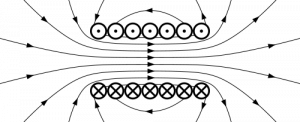Do you have a phone that has wireless charging capabilities? It can seem almost magical at times. It can also be pretty convenient, although charging with a wire can also have its advantages.
But how does it work? In the charging pad, there is a coil of wire that has a current running through it. [1] According to Ørsted’s law, an electric current will induce a magnetic field around it. This is used in solenoids, for example, a helix of wire that creates a relatively uniform magnetic field inside.

A cross section of a solenoid showing the electric current going out of the page on the top, around, and back into the page on the bottom. This creates a magnetic field going right. The direction of the magnetic field changes when the direction of the current changes. Credits: Wikimedia
However, in the charging pad, the current in the coil is actually an alternating current, which changes directions. Because the current changes, the direction of the magnetic field changes.
In the phone, there is also a coil which will respond to the changing magnetic field as described by Faraday’s law, which states that the magnitude of the electromotive force (which is not actually a force, but rather a potential) depends on the rate of change of the magnetic flux (which can be thought of how much of a magnetic field goes through an area).
In the case of induction charging, the changing magnetic field created by the coil in the charging pad will cause a changing magnetic flux in the coil in the phone. [2] This will result in a current whose direction depends on Lenz’s law, which states that the direction of the induced current will create a magnetic field in the direction that opposes the change in the original magnetic field. This can be a bit difficult to comprehend! As an example, if you have an magnetic field pointing up that is decreasing in magnitude, the induced electric current in the coil will have a magnetic field pointing up as well. And if the original field is increasing in magnitude, the induced magnetic field will point down instead.
The induced electric current is then converted to a direct current, and is then used to charge the battery! However, as one can imagine, this entire process is not as efficient as simply plugging the phone in, although there is ongoing research on improving the process. [2] But it’s still cool, and the principle behind it is used in many other applications!
Sources:
[1] Lu X, Wang P, Niyato D, Kim DI, Han Z. Wireless Charging Technologies: Fundamentals, Standards, and Network Applications. IEEE Commun Surv Tutorials. 2016;18(2):1413-1452. doi:10.1109/COMST.2015.2499783
[2] Bekaroo G, Seeam A. Improving wireless charging energy efficiency of mobile phones: Analysis of key practices. In: ; 2016:357-360. doi:10.1109/EmergiTech.2016.7737366
